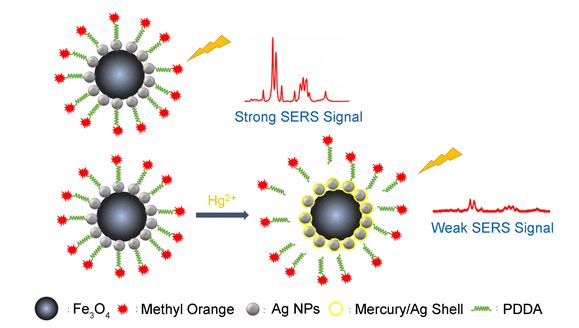| [1] Cai, F. D.; Zhu, Q.; Zhao, K.; Deng, A. P.; Li, J. G. Environ. Sci. Technol. 2015, 49, 5013.
[2] Zhang, C. Y.; Meng, Y. Z.; Kuang, J. Z.; Xu, L. Acta Chim. Sinica 2015, 73, 409. (张崇洋, 孟玉珠, 匡金志, 徐岚, 化学学报, 2015, 73, 409.)
[3] Wang, X. W.; Chen, S. Acta Chim. Sinica 2014, 72, 1147. (王晓伟, 陈莎, 化学学报, 2014, 72, 1147.)
[4] Wan, J.; Yin, G.; Ma, X. J.; Xing, L.; Luo, X. L. Electroanalysis 2014, 26, 823.
[5] Taylor, V. F.; Bugge, D.; Jackson, B. P.; Chen, C. Y. Environ. Sci. Technol. 2014, 48, 5058.
[6] Srivastava, R. K.; Sedman, C. B.; Kilgroe, J. D.; Smith, D.; Renninger, S. J. Air Waste Manage. Assoc. 2001, 51, 1460.
[7] Lee, C.; Choo, J. Bull. Korean Chem. Soc. 2011, 32, 2003.
[8] Wu, Y. G.; Zhan, S. S.; Xu, L. R.; Shi, W. W.; Xi, T.; Zhan, X. J.; Zhou, P. Chem. Commun. 2011, 47, 6029.
[9] Shah, A. Q.; Kazi, T. G.; Baig, J. A.; Afridi, H. I.; Arain, M. B. Food Chem. 2012, 134, 2345.
[10] Ye, B. C.; Yin, B. C. Angew. Chem., Int. Ed. 2008, 47, 8386.
[11] Lou, T. T.; Chen, L.; Zhang, C. R.; Kang, Q.; You, H. Y.; Shen, D. Z.; Chen, L. X. Anal. Methods 2012, 4, 488.
[12] Wu, X. F.; Ma, Q. J.; Wei, X. J.; Hou, Y. M.; Zhu, X. Sens. Actuators, B 2013, 183, 565.
[13] Rakkesh, R. A.; Durgalakshmi, D.; Balakumar, S. RSC Adv. 2016, 6, 34342.
[14] Qu, H.; Lai, Y.; Niu, D.; Sun, S. Anal. Chim. Acta 2013, 763, 38.
[15] Du, Y. X.; Liu, R. Y.; Liu, B. H.; Wang, S. H.; Han, M. Y.; Zhang, Z. P. Anal. Chem. 2013, 85, 3160.
[16] Li, D.-W.; Zhai, W.-L.; Li, Y.-T.; Long, Y.-T. Microchim. Acta 2014, 181, 23.
[17] Alvarez-Puebla, R. A.; Liz-Marzan, L. M. Angew. Chem., Int. Ed. 2012, 51, 11214.
[18] Kang, T.; Yoo, S. M.; Yoon, I.; Lee, S.; Choo, J.; Lee, S. Y.; Kim, B. Chem.-Eur. J. 2011, 17, 2211.
[19] Duan, J. L.; Yang, M.; Lai, Y. C.; Yuan, J. P.; Zhan, J. H. Anal. Chim. Acta 2012, 723, 88.
[20] Li, F.; Wang, J.; Lai, Y. M.; Wu, C.; Sun, S. Q.; He, Y. H.; Ma, H. Biosens. Bioelectron. 2013, 39, 82.
[21] Kang, Y.; Wu, T.; Liu, B. X.; Wang, X.; Du, Y. P. Microchim. Acta 2014, 181, 1333.
[22] Ojea-Jimenez, I.; Lopez, X.; Arbiol, J.; Puntes, V. ACS Nano 2012, 6, 2253.
[23] Ding, X.; Kong, L.; Wang, J.; Fang, F.; Li, D.; Liu, J. ACS Appl. Mater. Interfaces 2013, 5, 7072.
[24] Zhang, L.; Chang, H. X.; Hirata, A.; Wu, H. K.; Xue, Q. K.; Chen, M. W. ACS Nano. 2013, 7, 4595.
[25] Chung, E.; Gao, R.; Ko, J.; Choi, N.; Lim, D. W.; Lee, E. K.; Chang, S.-I.; Choo, J. Lab. Chip. 2013, 13, 260.
[26] Esmaielzadeh Kandjani, A.; Sabri, Y. M.; Mohammad-Taheri, M.; Bansal, V.; Bhargava, S. K. Environ. Sci. Technol. 2015, 49, 1578.
[27] Sun, B.; Jiang, X. X.; Wang, H. Y.; Song, B.; Zhu, Y.; Wang, H.; Su, Y. Y.; He, Y. Anal. Chem. 2015, 87, 1250.
[28] Deng, H.; Li, X. L.; Peng, Q.; Wang, X.; Chen, J. P.; Li, Y. D. Angew. Chem., Int. Ed. 2005, 44, 2782.
[29] Zhao, Y. L.; Tao, C. R.; Xiao, G.; Wei, G. P.; Li, L. H.; Liu, C. X.; Su, H. J. Nanoscale 2016, 8, 5313.
[30] Li, Z. X.; Zhao, A. W.; Gao, Q.; Guo, H. Y.; Wang, D. P.; Li, L. Acta Chim. Sinica 2015, 73, 847. (李振兴, 赵爱武, 高倩, 郭红燕, 王大朋, 李磊, 化学学报, 2015, 73, 847.)
[31] Ren, W.; Zhu, C. Z.; Wang, E. Nanoscale 2012, 4, 5902.
[32] Alvarez-Puebla, R. A.; Arceo, E.; Goulet, P. J. G.; Garrido, J. J.; Aroca, R. F. J. Phys. Chem. B 2005, 109, 3787.
[33] He, S. T.; Yao, J. N.; Jiang, P.; Shi, D. X.; Zhang, H. X.; Xie, S. S.; Pang, S. J.; Gao, H. J. Langmuir 2001, 17, 1571.
[34] Katsikas, L.; Gutierrez, M.; Henglein, A. J. Phys. Chem. 1996, 100, 11203.
[35] Ding, S.-Y.; Wu, D.-Y.; Yang, Z.-L.; Ren, B.; Xu, X.; Tian, Z.-Q. Chem. J. Chin. Univ. Chin. 2008, 29, 2569. (丁松园, 吴德印, 杨志林, 任斌, 徐昕, 田中群, 高等学校化学学报, 2008, 29, 2569.)
[36] Zhao, L. B.; Huang, Y. F.; Wu, D. Y.; Ren, B. Acta Chim. Sinica 2014, 72, 1125. (赵刘斌, 黄逸凡, 吴德印, 任斌, 化学学报, 2014, 72, 1125.)
[37] Mclellan, J. M.; Xiong, Y. J.; Hu, M.; Xia, Y. N. Chem. Phys. Lett. 2006, 417, 230.
[38] Wang, G. Q.; Lim, C.; Chen, L. X.; Chon, H.; Choo, J.; Hong, J.; Demello, A. J. Anal. Bioanal. Chem. 2009, 394, 1827.
[39] Ganbold, E.-O.; Park, J.-H.; Ock, K.-S.; Joo, S.-W. Bull. Korean Chem. Soc. 2011, 32, 519.
[40] Sun, Z. L.; Du, J. J.; Lv, B.; Jing, C. Y. RSC Adv. 2016, 6, 73040.
[41] Hou, M. J.; Huang, Y.; Ma, L. W.; Zhang, Z. J. Nanoscale Res. Lett. 2015, 10, 437.
[42] Mou, Y.; Lu, H.; Li, M.; Chen, C. Chin. J. Chem. 2017, 35, 435. |
